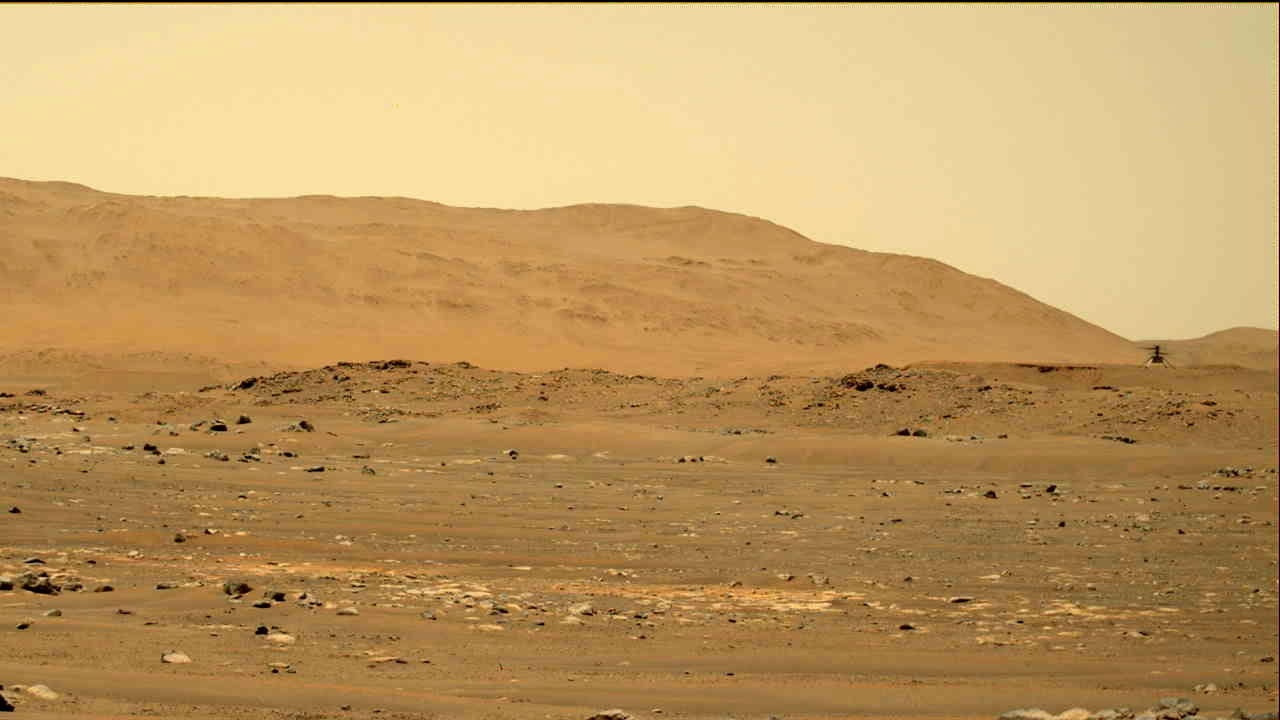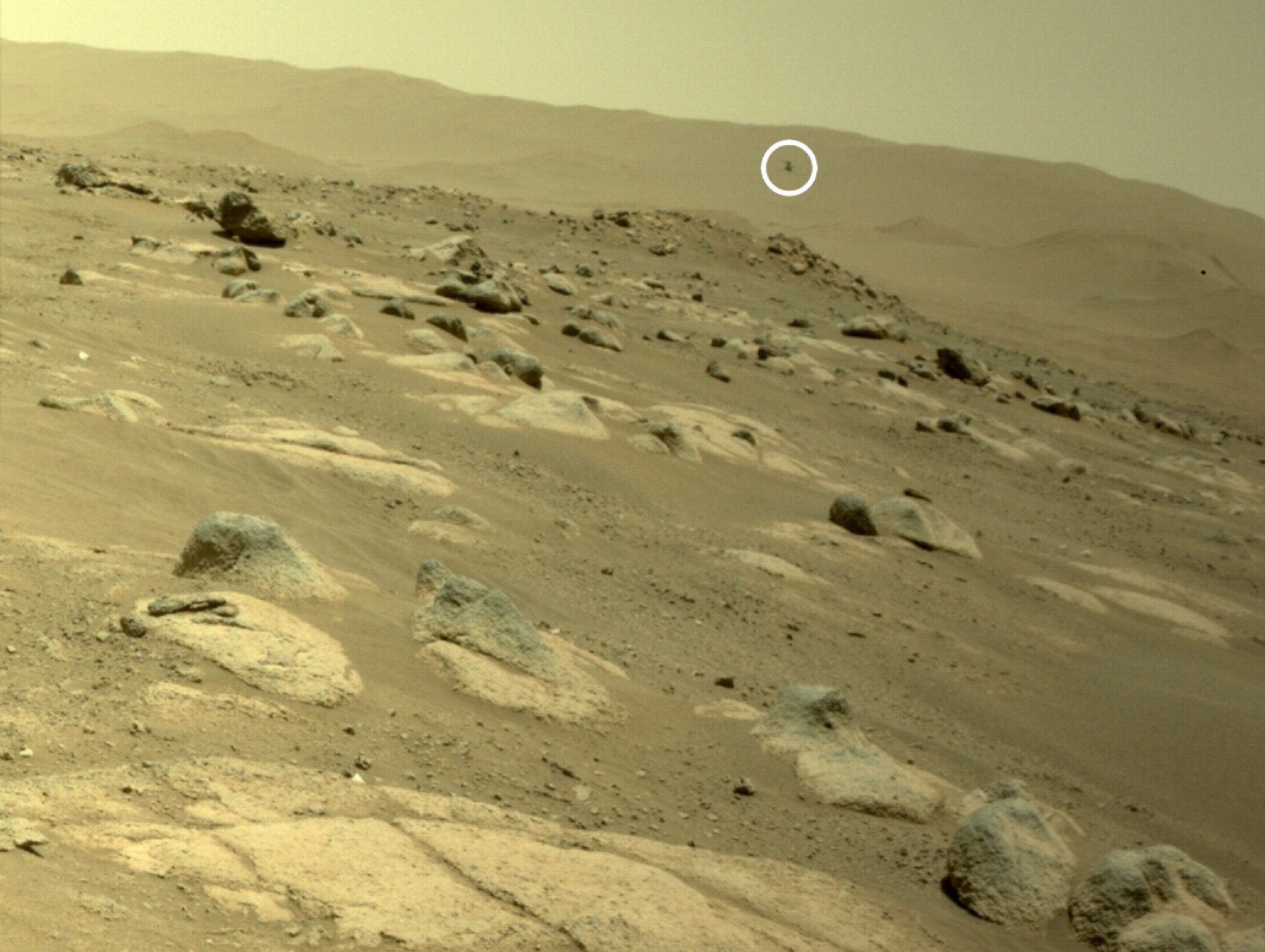NASA's Mars helicopter Ingenuity keeps pushing the aerial exploration envelope.
The 4-lb. (1.8 kilograms) chopper lifted off from the floor of Mars' Jezero Crater today at 10:49 a.m. EDT (1449 GMT), kicking off its fourth flight on the Red Planet.
Ingenuity achieved all of its main technology-demonstrating goals on flights one through three — which occurred on April 19, April 22 and April 25 — so the helicopter's handlers let it off the leash today. Ingenuity covered 872 feet (266 meters) of ground and reached a top speed of 8 mph (13 kph) during the 117-second jaunt, NASA officials said.
Related: How NASA's Mars helicopter Ingenuity can fly on the Red Planet

The previous highs, set on sortie number three, were 330 feet (100 m) of lateral distance, a 4.5 mph (7.2 kph) maximum speed and an 80-second flight time. (The maximum altitude attained — about 16.5 feet, or 5 m — has remained the same on the three most recent flights.)
If all went according to plan, Ingenuity also took 60 photos with its downward-facing navigation camera and five with its 13-megapixel color imager while aloft today, helicopter team members said.
We don't yet know if Ingenuity's robotic partner, NASA's Perseverance rover, will be in any of those shots. Ingenuity managed to spot the rover from the air during flight number three, capturing an image unprecedented in the history of exploration.
Get the Space.com Newsletter
Breaking space news, the latest updates on rocket launches, skywatching events and more!
Perseverance carries two onboard microphones, and the rover attempted to record sound of Ingenuity's flight today for the first time, mission team members said. Again, we'll have to wait until more data comes down to see if that did indeed happen.
Showing what's possible
Ingenuity and Perseverance landed together Feb. 18 inside the 28-mile-wide (45 kilometers) Jezero, which hosted a big lake and a river delta in the ancient past. Ingenuity deployed from the rover's belly on April 3 and began prepping for its flight campaign, which is designed to show that aerial exploration is possible on Mars.
And now we know that it is.
"Future Mars exploration missions can now confidently consider the added capability an aerial exploration may bring to a science mission," Lori Glaze, director of NASA's Planetary Science Division, said in a statement Wednesday (April 28).
Indeed, members of the Ingenuity team are already thinking about the next generation of Mars helicopters — bigger craft that could gather lots of data on the Red Planet and serve as scouts for rovers or human explorers.
Success 👏#MarsHelicopter completed its 4th flight, going farther & faster than ever before. It also took more photos as it flew over the Martian surface. We expect those images will come down in a later data downlink, but @NASAPersevere's Hazcam caught part of the flight. pic.twitter.com/Fx3UHu4jgvApril 30, 2021
A one-day delay

Ingenuity was supposed to fly yesterday (April 29), but the solar-powered copter didn't manage to get off the ground.
Ingenuity's debut Martian flight was also delayed, after the chopper didn't transition to flight mode as required to perform a high-speed rotor spin test. The mission team tweaked the command sequence beamed from Earth and got Ingenuity aloft on April 19, about a week later than originally planned.
That fix gets Ingenuity into flight mode about 85% of the time, mission team members determined. And it appears that yesterday was just one of those relatively rare occasions where it didn't work.
A mission extension
Ingenuity's flight campaign was initially capped at five hops over a one-month stretch from the deployment date. That deadline was imposed to allow Perseverance to start focusing on its own mission, which involves hunting for signs of long-gone Mars life and collecting samples for future return to Earth.
(Perseverance has been documenting and supporting Ingenuity's work; for example, communications to and from the helicopter must go through the rover.)
But Ingenuity's success to date has earned it a mission extension. NASA officials announced today that the chopper will soon move into a new "operations demonstration phase," which will last for at least 30 additional days on the Red Planet.
"It's like Ingenuity is graduating," mission project manager MiMi Aung, of NASA's Jet Propulsion Laboratory in Southern California, said during a news conference this morning.
In the new phase, "we can show how a rotorcraft can be used and show products that only an aerial platform, from an aerial dimension, can give," Aung said.
Flights four and five serve to transition Ingenuity to the new phase, which will kick off at an entirely new locale. The helicopter will fly to that to-be-determined new site on sortie number five, which is expected to take place in about a week, Aung said.
Ingenuity will fly less frequently during the new phase — likely once every two to three weeks as opposed to the tech-demo cadence of once every three days or so, NASA officials said. This will give Perseverance time to really dig into its science work. The rover also won't capture video of those coming flights, which will also free up considerable time, Perseverance team members said.
The newly granted extension does not come with a hard deadline; team members will assess how Ingenuity performed after the 30 days are up and decide whether or not to keep flying. But Ingenuity will definitely be grounded for good by late August, NASA officials said.
"That timing will allow the rover team time to wrap up its planned science activities and prepare for solar conjunction — the period in mid-October when Mars and Earth are on opposite sides of the sun, blocking communications," NASA officials wrote in an update today.
Mike Wall is the author of "Out There" (Grand Central Publishing, 2018; illustrated by Karl Tate), a book about the search for alien life. Follow him on Twitter @michaeldwall. Follow us on Twitter @Spacedotcom or Facebook.
Join our Space Forums to keep talking space on the latest missions, night sky and more! And if you have a news tip, correction or comment, let us know at: community@space.com.

Michael Wall is a Senior Space Writer with Space.com and joined the team in 2010. He primarily covers exoplanets, spaceflight and military space, but has been known to dabble in the space art beat. His book about the search for alien life, "Out There," was published on Nov. 13, 2018. Before becoming a science writer, Michael worked as a herpetologist and wildlife biologist. He has a Ph.D. in evolutionary biology from the University of Sydney, Australia, a bachelor's degree from the University of Arizona, and a graduate certificate in science writing from the University of California, Santa Cruz. To find out what his latest project is, you can follow Michael on Twitter.









